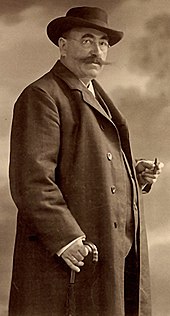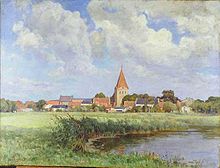Franz Bunke
Franz Wilhelm Johann Bunke (born December 3, 1857 in Schwaan , † July 6, 1939 in Weimar ) was a German painter .
Life
Franz Bunke was the son of the mill farmer of the same name, Franz Bunke, and his wife Christina Sophie Elisabeth, b. Dabbert. From 1871 he received drawing lessons from the Rostock painter Paul Tischbein (1820–1874) and, after his death, studied with Theodor Rogge from 1874 . At that time he also attended a trade school.
In 1878 he began studying art at the Academy of Arts in Berlin , but in the same year he switched to the Grand Ducal Saxon Art School in Weimar . There he was a master student of the landscape painter Theodor Hagen from 1882 to 1884 and received a teaching post for landscape painting in 1886 . In 1910 Grand Duke Wilhelm Ernst von Sachsen-Weimar-Eisenach awarded him the title of professor.
How Franz Bunke came to art and how he came to Weimar - he commented on this in two essays in the Mecklenburg monthly magazine .
Bunke was married to Ottilie Maria Minna, b. Fischer, and finally their widower. He lived and died in what is now the Oberweimar district , which has been incorporated into Weimar since 1922, and found his final resting place next to his wife in the old Weimar cemetery.
Schwaan artists' colony
From 1892 onwards, Bunke stayed regularly in Schwaan in the summer and founded an artists' colony there . Every summer he moved to his home town with some of the academy's students. At times, Peter Paul Draewing , Alfred Heinsohn , Rudolf Bechstein , Rudolf Bartels , Erich Venzmer , Wilhelm Facklam and Paul Müller-Kaempff also painted there .
Awards
- In 1880 he received the Golden Medal for Art from the Karl-Alexander Foundation in Weimar .
- In 1896 at the International Art Exhibition in Berlin , which took place on the occasion of the 200th anniversary of the Royal Academy of Arts in Berlin, he was awarded a small gold medal.
- In 1911 he received the Great Medal for Art and Science from Grand Duke Friedrich Franz IV for his work on the occasion of the art and trade exhibition in Schwerin .
- In 1927 he was made an honorary citizen of his hometown Schwaan, which also named a street after him.
Works
His most famous landscape motifs include drawings and oil paintings from his hometown Schwaan, Wiesen and Weiher on the Warnow and the neighboring villages.
He exhibited his works regularly at the exhibitions of the Berlin Academy of the Arts, the "Great Berlin Art Exhibitions" , from 1903 to 1914 also in the Munich Glass Palace and in 1914 in a painting exhibition in Vienna. In 1930 his works were shown in a solo exhibition in his hometown of Schwaan.
literature
- Lisa Jürß: Bunke, Franz Wilhelm Johann. In: Andreas Röpcke (Ed.): Biographical Lexicon for Mecklenburg. (= Publications of the Historical Commission for Mecklenburg : Series A). Volume 5, Schmidt-Römhild, Lübeck 2009, ISBN 978-3-7950-3746-8 , pp. 90-93.
- Heiko Brunner, Lisa Jürß: Franz Bunke: a work overview. Edition Fischerhuder Kunstbuch, 2007, ISBN 978-3-88132-076-4 .
- Lisa Jürß: Schwaan artists' colony. Gallery in the old watermill. Work catalog. Edition Fischerhuder art book 2002. ISBN 3-88132-295-7 .
- Bunke, Franz. In: Friedrich von Boetticher: Painter works of the 19th century. Contribution to art history. Volume 1/1, sheets 1–30: Aagaard – Heideck. Ms. v. Boetticher's Verlag, Dresden 1891, p. 143 ( archive.org ).
- Bunke, Franz . In: Ulrich Thieme (Hrsg.): General Lexicon of Fine Artists from Antiquity to the Present . Founded by Ulrich Thieme and Felix Becker . tape 5 : Brewer-Carlingen . EA Seemann, Leipzig 1911, p. 225 ( Textarchiv - Internet Archive ).
Web links
- Literature by and about Franz Bunke in the catalog of the German National Library
- Literature about Franz Bunke in the state bibliography MV
- Works by Franz Bunke in the state bibliography MV
- about Franz Bunke in the Schwaan Art Museum
- Painting by Franz Bunke in the Schwaan Art Museum
- Paintings by Franz Bunke on artnet
Individual evidence
- ↑ death certificate no. 597/1939 of the registry office Weimar
- ↑ How I came to art, and what it means to me: Memories of Franz Bunke. In: Mecklenburgische Monatshefte. Volume 1, 1925, pp. 574-579 ( digitized PDF; 840 kB).
- ↑ How I came to Weimar: Franz Bunke. In: Mecklenburgische Monatshefte. Volume 11, 1935, pp. 418-419 ( digitized PDF; 1.5 MB).
- ↑ Large Berlin Art Exhibition Catalog. Heidelberg University, accessed on September 2, 2015 .
- ^ Catalogs of the art exhibitions in the Munich Glass Palace 1869-1931. bavarikon, accessed on January 28, 2020 .
- ↑ A new landscaper. In: Fremd-Blatt Wien. May 4, 1914, accessed September 2, 2015 . at ANNO
| personal data | |
|---|---|
| SURNAME | Bunke, Franz |
| ALTERNATIVE NAMES | Bunke, Franz Wilhelm Johann (full name) |
| BRIEF DESCRIPTION | German painter |
| DATE OF BIRTH | December 3, 1857 |
| PLACE OF BIRTH | Swaan |
| DATE OF DEATH | July 6, 1939 |
| Place of death | Weimar |


